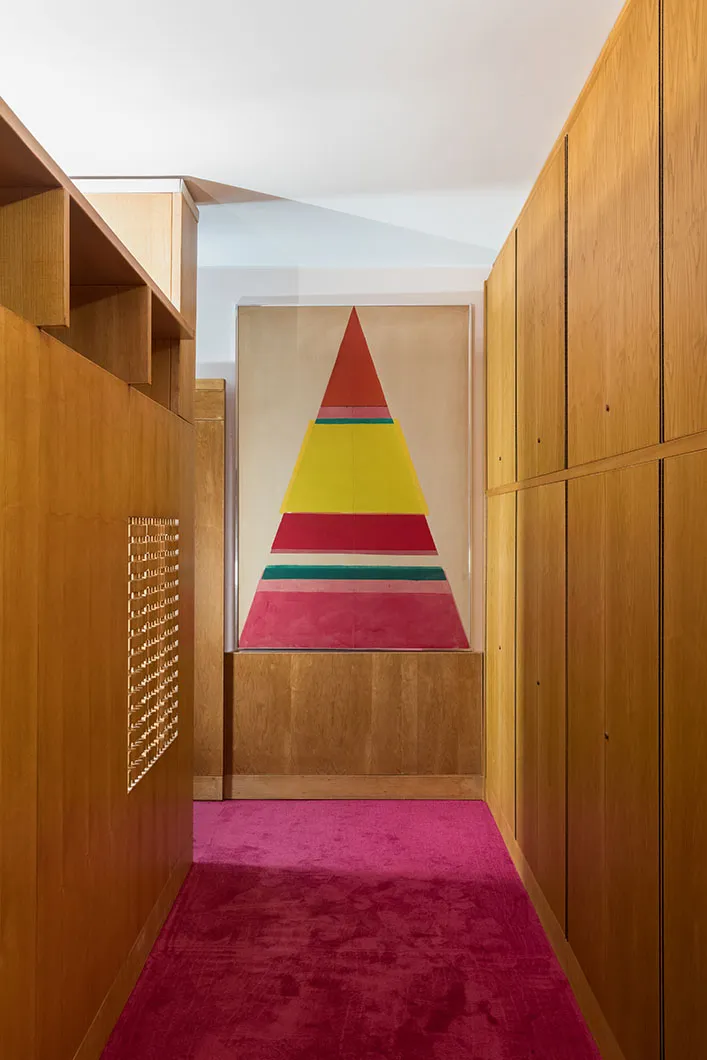750 drawings by Tadao Ando, Zanuso and Mulas’ travel journals, NYC's water system. Plus spatial aesthetics, Big Data, packaging, Milan, photos by Almodóvar and, of course, architecture and nature.
A house by Ettore Sottsass at Triennale Milano

Casa Lana, Sottsass © Triennale Milano. Ph Gianluca Di Ioia
An extraordinary thing happened at Triennale Milano. Almost 55 years after it was first produced, the central nucleus of a house built by Ettore Sottsass Jr. in 1967 was installed in the Palazzo dell’Arte.
In 1967, Ettore Sottsass Jr. designed the interiors of a large flat in the centre of Milan for a Mr Lana. It’s a very restrained and elegant space, generated by an internal partition, its sides covered with pale wood, which bring a feel of homely warmth to the space. The pops of colour were provided by the sofa covers, not leather, not high-end, but made of blue and pink fabric. “The central part with the sofas has been designed to feel very cosy, one can shut oneself off, hold very peaceful conversations, listen to music on the record player (in the corner) or stand up and help oneself to books, records and sweets from the surrounding shelves; one can read comfortably because there’s overhead lighting in the sofa alcoves and basically it’s all very easy.” (Sottsass Jr., 1967). This living room has no pretensions to being a place for showing off one’s treasures, it’s a relaxing room where everyday complications, fatigue and dissatisfactions can be left behind. The client was so fond of this living room that he made not a single alteration. Not one piece of furniture was moved, covering changed or component replaced. It’s exactly the same spatial design that Sottsass Jr. created in 1967.

Casa Lana, Sottsass © Triennale Milano. Ph Gianluca Di Ioia
Almost 55 years have passed since this house was finished and now, in December 2021, the central nucleus of Casa Lana is on display. It’s a wooden structure with sofas arranged in such a way as to create a cosy living area in which to chat and listen to music, while the surrounding space is arranged to cater for various activities and functions. The spaces are optimised because, by doing away with corridors, as Ettore Sottsass said, “a little piazza is created in which one can move around and get together” (Sottsass Jr., 1967). It was Barbara Radice Sottsass’s decision, supported by the client’s daughter, to donate the house to the Triennale di Milano, which moved it carefully and set it up permanently on the first floor of the Palazzo dell’Arte
The press conference was a very moving occasion. Marco Sammicheli, Director of the Italian Design Museum at Triennale Milano, quoted from Franz Kafka’s Dreams, sitting next to Barbara Radice, who thanked Ettore Sottsass himself, reading out an excerpt from his last book Di Chi Sono le Case Vuote? (Whose are the Empty Houses?) recently published by Adelphi. With them on the stage were Stefano Boeri, President of Triennale Milano, Carla Morogallo, Director of Operations at Triennale Milano, and Tommaso Sacchi, Councillor for Culture of the City of Milan.
Exhibitions and events have been planned around the permanent Casa Lana installation, which will highlight various different aspects of the work and thinking of the master. Alongside the exhibitions, a series of dedicated donations will become the nucleus of an important corpus of works by the architect Ettore Sottsass Jr. as part of the Triennale Milano’s permanent collection. The installation of the room and its philological reconstruction were the subject of in-depth study by the archive and the conservation department at Triennale Milano, and involved Luca Cipelletti, who curated the installation in the central space on the first floor of Triennale, and Christoph Radl, who took care of the art direction of the project, amongst others.

Casa Lana, Sottsass © Triennale Milano. Ph Gianluca Di Ioia
From Thursday 2nd December 2021 onwards, visitors will have an opportunity to look at Sottsass’s architecture through his own eyes and experience a space designed by him. A priceless opportunity, and especially one that remains open to the public free of charge, yet another testament to the fact that Triennale Milano is always open to the city and its users. The installation of the house, in the middle of the room, is “embraced” by the exhibition Ettore Sottsass. Structure and Colour, one of a series of shows curated by Marco Sammicheli with the installation and artwork by Christoph Radl. Marco Sammicheli had this to say: “inspired by the narrative triggers at Casa Lana, we conceived a series of exhibitions tackling some of the leading themes of the master’s work.”



















